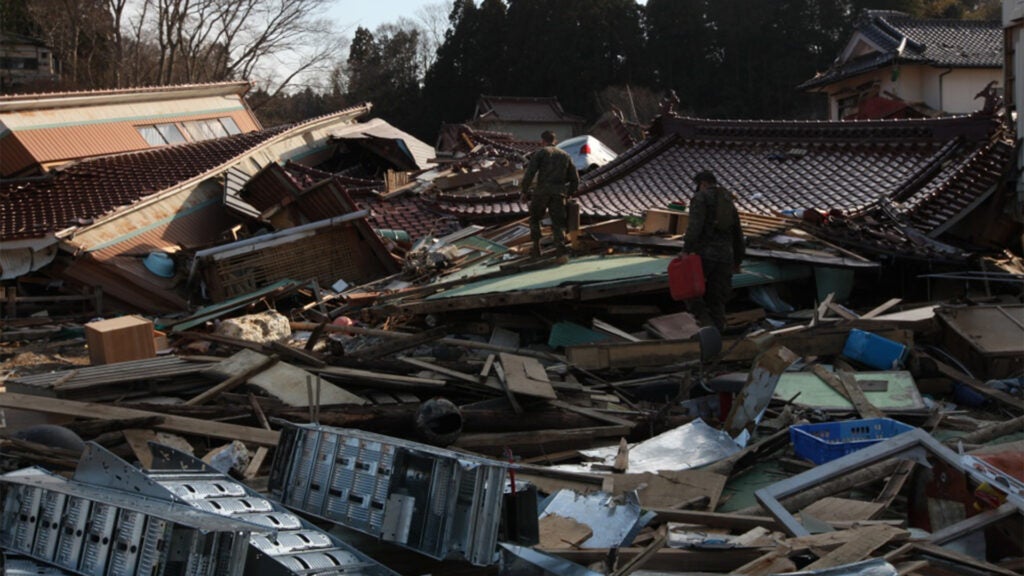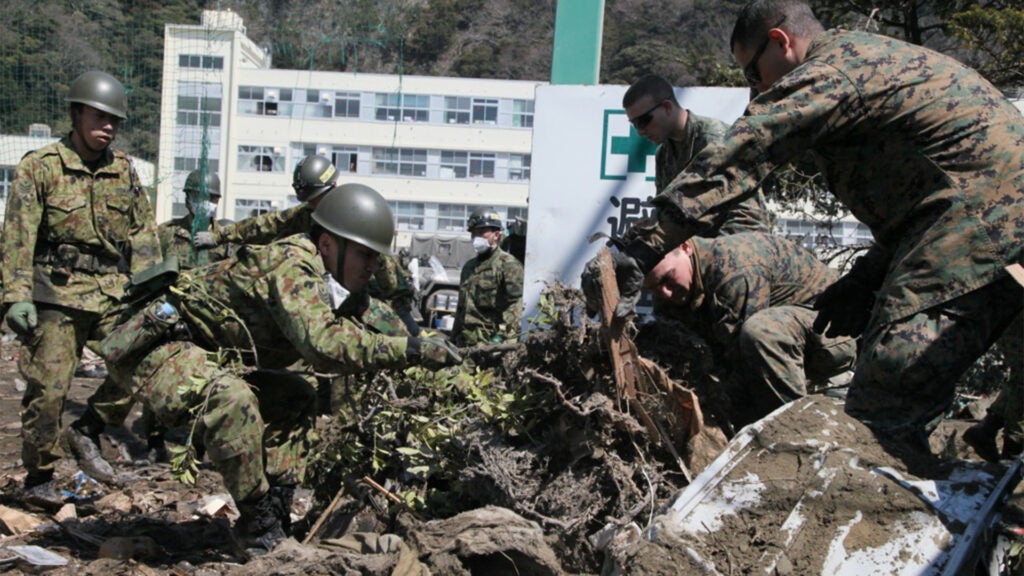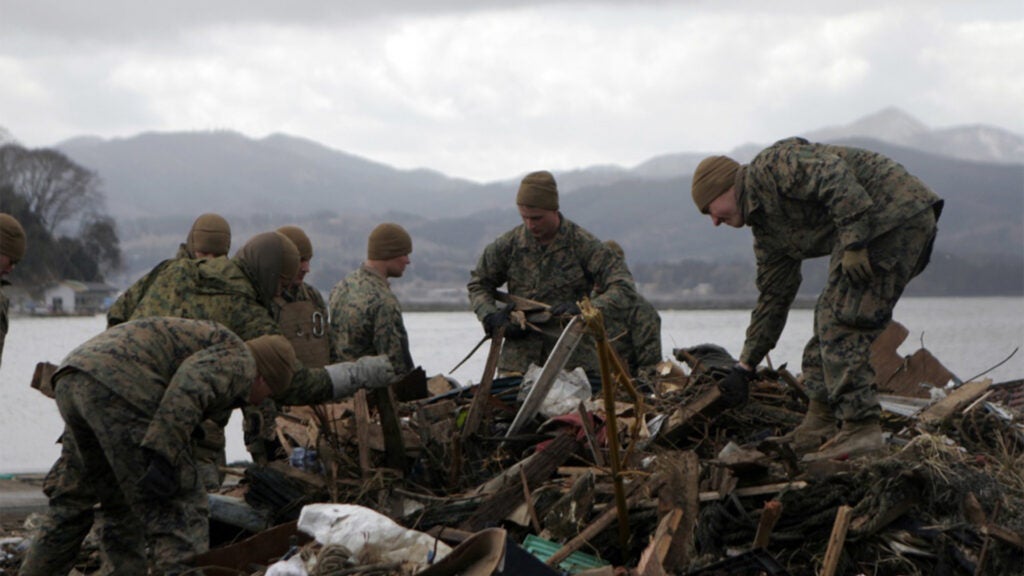Lt. Col. Giuseppe Stavale was in a situation no parent wants to be in. It was early afternoon on March 11, 2011, and a massive earthquake, followed by a 140-foot tall tsunami, had just struck the coast of northeast Japan. The city of Tokyo, where Stavale was stationed, was shaking around him, and he could not find his teenage daughter.
“I was trying to get in touch with my daughter to ensure she was ok, but all the cellular phone networks stopped working, either due to outages or being overwhelmed by volume of calls,” the Marine said in a recent press release. “We were watching the news footage, seeing collapses, and we realized that it reached much further than Tokyo, it was extensive.”
Fortunately, Stavale managed to track down his daughter and pick her up in his car. His wife, meanwhile, survived with their twins while taking shelter in the family living room. They were the lucky ones. Nearly 16,000 people lost their lives in what became known as the Great East Japan earthquake, and the ensuing Fukushima Daiichi nuclear disaster, which the earthquake and tsunami set off.
Now, on the ten-year anniversary of the triple-catastrophe, the Japanese government and the U.S. Marine Corps took time to remember both the massive losses of the event and the monumental efforts of Japanese first responders, civilians, and nearly 25,000 American service members who worked together to rebuild in the face of disaster.
“We had this big earthquake, followed by a massive tsunami, followed by a nuclear disaster, and we had the thought that if anyone ever tried to introduce all those factors into an exercise, they would be fired,” said Stavale, who was a Major at the time and has since retired. “That would never be allowed to be a scenario, never be allowed to happen, because it was so unlikely. But it happened.”

In its wake, nearly a million buildings were damaged or destroyed; 6 million households were without power or water; many areas of the coastline were flooded, and a 30 km no-go zone was created due to radiation from the nuclear meltdown. For context, the earthquake was the most powerful ever recorded in Japan, and the fourth-most powerful worldwide since modern record-keeping began in 1900. Meanwhile, the only nuclear disaster worse than Fukushima was the Chernobyl disaster of 1986. So Japan was basically wrecked by three heavy-weight historic catastrophes all at once.
Over the ensuing months, Marines and local Japanese worked together to search for and rescue survivors, clear out debris, rebuild airfields, treat injuries, distribute food, water, and supplies, get electricity up and running, and perform the countless other tasks of getting an entire country back on its feet. The Marines immediately got to work restoring a major airfield far faster than anyone would have thought possible.
“When we first arrived at [Sendai] airport, local officials thought it would take months to get aircraft back in there,” said Maj. Gen. Craig Timberlake, then a brigadier general, who had been in command of the Japan-based 3rd Marine Expeditionary Brigade for only four days when the triple-catastrophe struck.
Luckily, Col. Craig Kozeniesky was on the scene. The commanding officer of Camp Fuji, Kozeniesky didn’t wait for permission from command before trucking in Marines and heavy equipment to Sendai airport to get it reopened as soon as possible. Instead of taking months, it took a mere three days for relief flights to start landing again to drop off supplies and recovery experts.
“How that happened was probably a miracle, because we were told that Sendai airport — the busiest in the northeast — was a total loss,” said Lt. Col. Stavale. “But here come the Marines from Fuji with their ‘can do’ attitude, and their willingness to help … Once they cleared that runway, and the relief flights became regular, it gave everyone a lot of hope.”
Related: Marine awarded for saving elderly woman from deadly viper attack
Elsewhere, Marines, soldiers, sailors, and airmen soon found out how big an impact a small difference can make in a disaster zone. A shower unit near Camp Sendai was “essential for cleanliness and very therapeutic,” Stavale said; a load of sports energy gels kept people fueled; and a shoulder to cry on gave an elderly Japanese woman a chance to let out some of the pressure of the catastrophe. Stavale said he was proud to provide that shoulder, and he was proud of helping clean out schools in Ishinomaki and installing radiation monitoring devices in the meltdown area. However, none of it would have happened without two essential ingredients: communication and relationships.
“This is why we need people that learn Japanese, know who to talk to, know who your counterparts are,” said Stavale. “It’s not just a person on the other end of the phone, or a radio, but understanding who they are and how they think.”
As a Foreign Area Officer with an education in Japanese, Stavale was well-positioned to provide that understanding. He helped Marines and locals work together, which was especially important in Japan, where an emergency response infrastructure already exists.
“The 3rd Marine Expeditionary Force had done many humanitarian assistance/disaster relief missions in third-world countries … However, we had never done this sort of mission in a first-world developed nation,” Maj. Gen. Timberlake said. “We had to complement Japanese military assistance and not compete with their robust efforts.”

One person in particular who enabled the joint effort was Dr. Robert Eldridge, the political advisor and Japanese government expert for the Americans in Sendai. Multiple Marines credited Eldridge for making the partnership between the two countries stick.
“Dr. Eldridge had prior existing relationships, intense knowledge of the culture, language, political processes, and understood how to work with people,” said Timberlake. “Every time we had an issue, he was one of the first people I talked with. Without him, we would not have been as successful as we were. It is now ten years later I don’t believe anybody has done as much to further the relationship between the U.S. and Japan than Dr. Eldridge.”
In a 2020 interview with Japan Times, Eldridge said that his proudest achievement was his work during Operation Tomodachi (literally Operation Friends), the name for the U.S. military relief effort for Japan. In 2015, Japan Times reported that Eldridge was dismissed from his position as a Marine Corps advisor after leaking surveillance footage of an anti-base protest to a Japanese neo-nationalist YouTube channel. Still, he made a big impact during Tomodachi, Marines said in the press release.
“He introduced [military leaders] to the right officials and explained how agencies plug into each other, and made it work,” said Stavale. “He was the right guy at the right time, and he deserves a lot of recognition.”
Though the Americans were there to help Japan, Stavale noted that the Japanese taught Americans many lessons along the way.
“The Japanese probably taught us more than we taught them about how to behave amidst disaster. Some people use the word ‘resilient’ or ‘stoic,’” the Marine recalled. “Unfortunately, in U.S. disasters recently, we saw some disappointing stuff, to include looting, fraud, price gouging, and other things. There of course is a lot of goodness too, not to discount that, but the Japanese showed how although it may be very tough and there may be a lot of personal pain, they were resilient and moved forward.”
For example, U.S. helicopters would deliver supplies to isolated areas, only to be turned away by local Japanese who preferred to wait until everyone had enough to share, Stavale said.
“There is a lot about that which we Americans can learn from,” he added.

Of course, the Japanese were not the only ones to benefit from Operation Tomadachi. Maj. Gen. Timberlake noted that the Japan-U.S. relationship was and is “the cornerstone of security in the Indo Pacific,” and that it was important to demonstrate how the U.S. helped its allies “especially in the eyes of potential adversaries.”
That alliance has become increasingly important as China moves to rival the U.S. for control of the Pacific. However, not all Japanese appreciate America’s presence in their country. While a record 82 percent of Japanese reportedly had friendly feelings towards the U.S. following Operation Tomodachi, according to the New York Times, some critics said the operation was used to justify controversial Marine basing locations on the southern island of Okinawa, which many islanders still oppose to this day.
Thirty-one of the 85 U.S. military facilities in Japan are on Okinawa, despite it being among the poorest and smallest of Japan’s prefectures, the Council on Foreign Relations wrote in 2019. Despite the bases bringing economic benefits such as jobs, many Okinawans resent the American presence there due to the bloody World War II battle that took place on the island (which killed nearly a third of Okinawa’s inhabitants); notorious incidents of rape of local women and girls by U.S. service members; and hundreds of dangerous military aircraft mishaps that took place near local hospitals and schools.
Residents point to the Marine Corps Air Station Futenma in particular for its poor placement in the middle of the city of Ginowan, which The Guardian once compared to having F-22s landing in Hyde Park, London (a bit like New York City’s Central Park). The U.S. has since agreed to move the base to a less populated area of the island, though the tension on Okinawa remains. Though the U.S. military’s presence on the island has been a source of controversy, the Marines and other service members stationed there definitely proved themselves useful after that day in March ten years ago.
“The very day the earthquake occurred, Yokota Air Base accepted emergency divert flights from Japanese commercial airports,” Stavale said. “Those Japanese civilian flights landed on our military base, where the service members took care of hundreds of stranded passengers, giving them food, information, shelter, and helping to coordinate onward movement. This set the conditions on how we were going to take care of our friends.”
Related: The US and Japan just teamed up for multiple joint air and sea exercises in a message to China
The post What it was like for Marines responding to one of the worst nuclear disasters in history appeared first on Task & Purpose.
